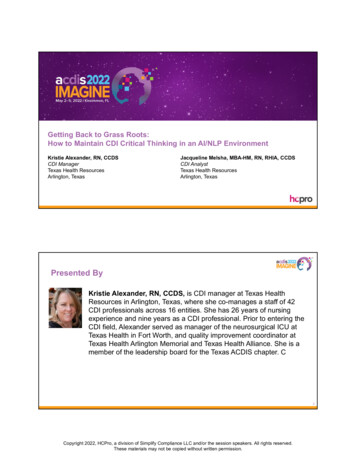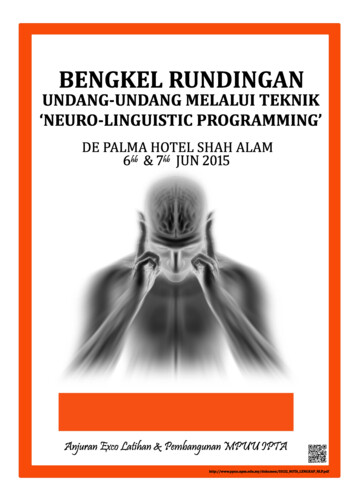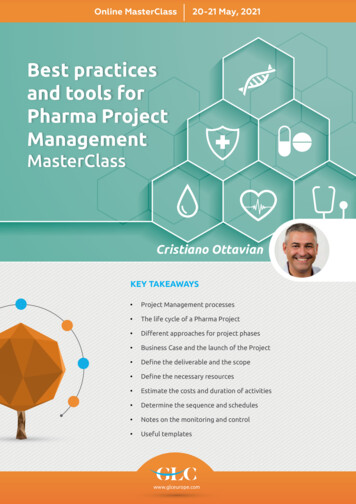
Transcription
Getting Back to Grass Roots:How to Maintain CDI Critical Thinking in an AI/NLP EnvironmentKristie Alexander, RN, CCDSCDI ManagerTexas Health ResourcesArlington, TexasJacqueline Melsha, MBA-HM, RN, RHIA, CCDSCDI AnalystTexas Health ResourcesArlington, Texas1Presented ByKristie Alexander, RN, CCDS, is CDI manager at Texas HealthResources in Arlington, Texas, where she co-manages a staff of 42CDI professionals across 16 entities. She has 26 years of nursingexperience and nine years as a CDI professional. Prior to entering theCDI field, Alexander served as manager of the neurosurgical ICU atTexas Health in Fort Worth, and quality improvement coordinator atTexas Health Arlington Memorial and Texas Health Alliance. She is amember of the leadership board for the Texas ACDIS chapter. C2Copyright 2022, HCPro, a division of Simplify Compliance LLC and/or the session speakers. All rights reserved.These materials may not be copied without written permission.
Presented ByJacqueline Melsha, MBA-HM, RN, RHIA, CCDS, is a CDI analyst atTexas Health Resources based in Arlington, Texas. She earned herMBA with a focus in healthcare management as well as her nursingand informatics degrees from Western Governors University Texas.She has served as a Texas ACDIS chapter leader since 2019 and hasmore than eight years of CDI experience.3Learning Objectives At the completion of this educational activity, the learner will be able to:– Identify examples of missed opportunities when relying on Artificial Intelligence (AI) and failto promote an environment of critical thinking– Explain how the lack of critical thinking can affect the CDI efforts– Describe opportunities to use critical thinking in individual CDI record review practices– List ways critical thinking (human component) can positively affect outcomeswhen combined with AI/Natural Language Processors (NLP)4Copyright 2022, HCPro, a division of Simplify Compliance LLC and/or the session speakers. All rights reserved.These materials may not be copied without written permission.
Who We Are Large healthcare system with headquarters in Arlington, TexasCDI program at 15 entities across Dallas-Fort WorthCDI departmentSenior directors for CDI and codingTwo (2) CDI managersCDI analystCDI educator38 CDI specialistsRN or HIM backgroundsCDI experience range from 1 year to 13 years5ScenarioJohn is cooking for a July 4th family gathering. He has 10 lbs. of ribs, 25 lbs. ofbrisket, and 5 lbs. of sausage.John’s brother Chris and sister Cindy are coming with their families including 6kids for the celebration.Cindy’s husband is bringing his electric smoker and all the cooking utensils andcondiments for the meat. They’ve loaded up the truck and are headed to John’sparent’s lake house where they will eat, swim, and shoot off fireworks to celebratethe holiday.It will take approximately 15 minutes to drive there and, on the way, John stops atthe local convenience store. How much charcoal will John need to purchase tocook all 40 lbs. of that meat?6Copyright 2022, HCPro, a division of Simplify Compliance LLC and/or the session speakers. All rights reserved.These materials may not be copied without written permission.
What Is Critical Thinking?7Definitions of Critical Thinking “Critical thinking is that mode of thinking - about any subject, content,or problem - in which the thinker improves the quality of his or her thinking byskillfully taking charge of the structures inherent in thinking andimposing intellectual standards upon them.” (Critical Thinking, n.d.) “The ability to think critically, as conceived in this volume, involves three things:1) an attitude of being disposed to consider in a thoughtful way the problems and subjectsthat come within the range of one's experiences,2) knowledge of the methods of logical inquiry and reasoning, and3) some skill in applying those methods.” (Critical Thinking, n.d.)Source: hinking/7668Copyright 2022, HCPro, a division of Simplify Compliance LLC and/or the session speakers. All rights reserved.These materials may not be copied without written permission.
Why is Critical Thinking so Important? Your car mechanic– Where is that noise coming from?– What is causing that noise?– How much money do I have to spend on repairs? Your kitchen sink plumber– Where did that water come from?– How do I make this go away?– How do I prevent it from happening again?9Why is Critical Thinking so Important In medicine, critical thinking is apuzzle– Something missing– Something doesn’t fit– Something doesn’t look right– Picture doesn’t make sense10Copyright 2022, HCPro, a division of Simplify Compliance LLC and/or the session speakers. All rights reserved.These materials may not be copied without written permission.
Critical Thinking as a CDI Professional One of the most important skills to learn, to develop, and to maintain Education, communication, collaboration, and experience all contribute to theability to critically think Incorporates problem solving, analysis, interpretation, inference, and openmindedness11Where Does Critical Thinking Come Into Play With CDI? Critical thinking is essential it is the key component of CDI– Early in CDI, critical thinking is all we had Our assessment/analytical skills and critical thinking– Requires attitude, knowledge, application, and skill Fast forward to 2022, many CDI programs have AI software to assist them intheir roles– Does AI replace critical thinking? Not at all!12Copyright 2022, HCPro, a division of Simplify Compliance LLC and/or the session speakers. All rights reserved.These materials may not be copied without written permission.
AI and NLP13What is AI/NLP? Artificial “Man-made” (not natural)Uses logic and rules to identify key words and phrasesConsists of electronic decision trees, algorithmsAt a very basic level – AI is technology which has been designed to assist instreamlining the CDI review process– Processing large volumes of data very quickly– May help to prioritize charts for review (i.e., those with greatest potential opportunities) A tool– When used properly, it can be a valuable asset to your program, but used as your corecomponent, many opportunities may be missed14Copyright 2022, HCPro, a division of Simplify Compliance LLC and/or the session speakers. All rights reserved.These materials may not be copied without written permission.
Advantages of AI/NLP AI can help to identify a diagnosis a CDS might have otherwise not considered- Lack of experience- Lack of disease specific knowledge Potential benefit for both experienced and inexperienced CDS– May help to bridge gaps in knowledge Presents opportunity to supplement your CDI program15Potential Challenges/Disadvantages of AI/NLP What happens if software goes down? (Internal disaster or external source)– Some CDI programs become dependent– Would you forget how to be a CDI without your software? AI cannot prompt you in everything– Limited diagnosis algorithms– Can’t determine POA, conflicting documentation– Can’t identify principal diagnosis (PDX) and/or reason for admission from observation(OBS) to inpatient status Spelling issues – i.e., “h/o”, “histroy”, “hx of” - may prevent appropriate capture16Copyright 2022, HCPro, a division of Simplify Compliance LLC and/or the session speakers. All rights reserved.These materials may not be copied without written permission.
Points to Consider Know the tool that you use! Learn how to use it most effectively to assist you.But recognize, it’s simply a tool, it should not be used as a substitute. A CDI program without critical thinking will never produce optimal results.–You can’t forget the basics! Never prioritize AI above critical thinking!17Our Experience18Copyright 2022, HCPro, a division of Simplify Compliance LLC and/or the session speakers. All rights reserved.These materials may not be copied without written permission.
What We Have Observed/Identified We incorporated an AI software program into our CDI department (30 CDI)– Learning the software was a lengthy process requiring training/follow-up beyond initialvendor training.– Protocols/guidelines were needed for staff reference.– Staff tended to become very task oriented.– Due to process required and staff fatigue related to workflow, critical thinking was negativelyaffected.– Changes/updates to software program requires continual staff education, updates toworkflow and processes (i.e., updates to department guidelines and monitoring forcompliance)– Identified critical thinking opportunities required a focused plan19What Did We Do? Implemented plan for quality audits beginning in 4Q 2019– Quality audit for each staff member every quarter– Criteria to audit determined Redefined criteria as needed with policy and software updates Education plan– Disease specific, software changes, Coding Clinic updates, etc.– Variety of mediums (i.e., software vendor, external vendors, internal (CDI dept.) and/orcollaboration with coding) Encouraged “second looks” by peers– Share best practices, learn from each other Prebill variance process– Review of variances with feedback from CDI leadership (analyst, educator, and/or managers)20Copyright 2022, HCPro, a division of Simplify Compliance LLC and/or the session speakers. All rights reserved.These materials may not be copied without written permission.
Potential Missed Opportunities21Types of Missed Opportunities Coding guidelinesClinical validationCoding ClinicPotential limitations of software interfacing with EHRConflicting documentationContinuityOBS to inpatientPOA22Copyright 2022, HCPro, a division of Simplify Compliance LLC and/or the session speakers. All rights reserved.These materials may not be copied without written permission.
Case Study 1oH&P: Problem list: History of CAD (coronary artery disease) s/p stentPlan: History of CAD: atenolol, Crestor, Effient, IsosorbideoAdditional Documentation:Cardiology Consult: Unstable Angina. H/O CAD, PCI 2015. Stress Test normal last year.Hospitalist: Admitted for worsening chest pain concerning for unstable angina, has h/o CAD.oTreatment:PCI with stenting of mid RCA with DESoooConflicting DocumentationProvider documents CAD as ahistory of but then documentsa list of medications the patientis currently taking that could beused to tread CADRequires CDS to haveknowledge of CodingGuidelinesOUTCOMEOPPORTUNITYISSUEo Query opportunity: CAD withunstable angina, CAD withoutangina/ischemic chest pain, or isit just a history of CAD?ooNo query sent by CDISpecialistNLP picked up CAD23Case Study 2oH&P:oAdditional Documentation:Hospitalist: Acute respiratory failure with hypoxiaTemp: 97 Pulse: 75 Respirations:16 BP: 146/66 Sp02: 94% on room air (lowest spo2 reading on room air)Physician exam: Pulmonary: Pulmonary effort is normal. No respiratory distress. Breath sounds: Normal breath sounds. Nowheezing.oTreatment: 2L oxygen via nasal cannulaPhysical Assessment: Lungs: Good air entry bilaterally. No added sounds. No wheezeProblem List: Acute on chronic respiratory failure with hypoxiaPlan: No mention of acute on chronic respiratory failure with hypoxia.ISSUEooAcute respiratory failure notclinically supported.NLP coded acute respiratoryfailure with hypoxia because itis documented.OPPORTUNITYo Clinical validation queryopportunity for acute respiratoryfailure with hypoxia.OUTCOMEooNo Clinical Validation querysent by CDS.NLP picked up acuterespiratory failure withhypoxia.24Copyright 2022, HCPro, a division of Simplify Compliance LLC and/or the session speakers. All rights reserved.These materials may not be copied without written permission.
Case Study 3oH&P:–oAdditional Documentation:–Cardiology Consult: Acute Pulmonary Edema in context of CHF, patient also has ESRD on dialysis.oTreatment: IV Lasix, Echo, CXR, DialysisPlan: SOB due to hypervolemia, Acute on chronic diastolic CHF, Acute Pulmonary Edema, ESRDISSUEooCapture of pulmonary edemaby the NLP.Knowledge of coding clinicregarding pulmonary edemawould be needed by CDS.OPPORTUNITYOUTCOME:oo Query to clarify the underlyingcause of the pulmonary edema;is it cardiogenic or noncardiogenic origin? Is it due toCHF or is it due to ESRD?ooNLP picked up acutepulmonary edemaNo triggers to query for theunderlying causeNo query sent by CDS25Case Study 4oH&P:–oAdditional Documentation:Plan: Pancytopenia due to chemotherapy, Nausea/Vomiting, Breast cancer, Lung mets–Hospitalist: Pancytopenia due to chemotherapy, nausea/vomiting–Dietary Consult (did not cross over from EMR to CDI software): Meets criteria for severe malnutrition as evidence by 10lbweight loss (5% in one month) and 50% energy requirement for 5 days. Poor appetite, unable to keep food down due.–65 y.o. with breast cancer with metastasis to lung. Currently on chemotherapy. Poor appetite, 10 lb. unintentional weight loss,nausea/vomiting x2 weeks.o Treatment: Dietary Consult, Boost TIDISSUEooDietician used a progress notenot recognized by the interfacebetween the EMR and CDISoftware. The only clinicalindicators for malnutritionwere found within the dietaryprogress note.No Triggers for malnutritionidentified by CDI softwareOPPORTUNITYo Query to clarify if patient hasmalnutritionOUTCOME:ooNo triggers to queryfor malnutritionNo query sent by CDS26Copyright 2022, HCPro, a division of Simplify Compliance LLC and/or the session speakers. All rights reserved.These materials may not be copied without written permission.
Case Study 5oH&P:–oAdditional Documentation:–Hospitalist: h/o seizure – on Dilantin–Plan: H/O Seizure: discontinue Dilantin. PCP has weaned off over last 2 years. No seizure for 40 years.Consult: seizure disordero Treatment: cumentationNLP picked up code forseizure disorderAI did not identify theconflicting documentationbetween History of seizuredisorder and conflictingdocumentation on currenttreatment with Dilantin.o Query to clarify if seizuredisorder is current/activecondition for this admission andif patient is currently receivingDilantin or have they beenweaned off?OUTCOME:ooNo triggers to query for theconflicting documentationNo query sent by CDS27Case Study 6oH&P:68 y.o. with HTN, DM2, recurrent UTI's presented with chills and fever 102.1, pulse 120Plan: Sepsis due to UTI.oAdditional Documentation:Hospitalist Day 2: Sepsis due to UTIHospitalist Day 3: UTI, Urine Culture E. ColiDischarge Summary: UTIo Treatment: IVF bolus 1500 mL, IV Vancomycin, IV Zosyn, Urine cultureISSUEooNLP picked code for Sepsissince it was documented inH&P and day 2 progress note.Sepsis not consistentlydocumented through to thedischarge summary.OPPORTUNITYo Query to clarify if sepsis is ruledin/out and clarify/link thecausative organism.OUTCOME:oooTrigger for sepsis specificitysince sepsis was documentedin addition to documentation oforganism (Urine culture E.coli)No triggers for the inconsistentdocumentation of sepsis.No query by CDS to clarify ifsepsis was ruled in or ruled out28Copyright 2022, HCPro, a division of Simplify Compliance LLC and/or the session speakers. All rights reserved.These materials may not be copied without written permission.
Case Study 7oH&P:Plan: Probable UTI, Tachycardia possibly due to dehydration. WBC: 7.4, Lactic Acid: 2.0, Procalcitonin: 0.25,Pulse: 122 Temp: 101.1oAdditional Documentation:Hospitalist Day 3: Sepsis, Gram Positive Bacteremia, UTIHospitalist Day 4: Sepsis, Gram Positive Bacteremia, UTIDischarge Summary: Sepsis, Gram Positive Bacteremia, UTIo Treatment: Blood Cultures x2, Urine Culture, IV Vancomycin, IV Rocephin , 1,710 Normal Saline Fluid BolusISSUEooSepsis not documented untilday 3 of the stay.The POA status of thisdiagnosis is not clear.OPPORTUNITYo Query to clarify POA status ofSepsiso Query for further specificity ofsepsis- link the localizedinfection and causative organismOUTCOME:oooTrigger for sepsis specificitysince sepsis was documentedin addition to documentation oforganism.No Triggers for clarification onthe POA status of SepsisCoding sent query to clarify thePOA status of Sepsis.29Case Study 8oH&P:oAdditional Documentation:Hospitalist Day 2: A fib. Upgrade to inpatient status for worsening SOB. ECHO shows reduced LVEF 40-45%. CHF.Hospitalist Day 3: Acute on chronic systolic CHF, A fib with RVRDischarge Summary: Acute on chronic systolic CHF, A fib with RVRPlan: Admitted to PCU on observation for atrial fibrillation. Started on Cardizem drip BNP 595.CXR Impression: Pulmonary Vascular congestion with interstitial edema.systolic function.o Treatment: Cardizem drip, ECHO, Cardiology consult, IV LasixISSUEooooPatient upgraded from obs toinpatientAI cannot identify PDXAI cannot determine reason forupgrade from obs to inpatientCDS must review both EMRand CDI software forobs/inpatient ordersOPPORTUNITYo Query to clarify reason forupgrade from observation toinpatientOUTCOME:ooNo triggers to further clarifyreason for upgrade fromobservation to inpatientCoding sent query to furtherclarify reason for upgrade fromobservation to inpatient.30Copyright 2022, HCPro, a division of Simplify Compliance LLC and/or the session speakers. All rights reserved.These materials may not be copied without written permission.
Challenges31AI and the EHR Document not crossing over from EMR to CDI software. Document may containmany clinical indicators for a diagnosis that would not be captured by the CDIsoftware.– Dietician’s template/document does not cross over to CDI software. Query opportunities could be missed if solely rely on the AI to identify. Must look in both CDI software and EMR to ensure everything is captured.– This supports that CDS must understand how the tool they are using works. Scanned documents– Cannot assume CDI software can “read” the content in the scanned document. Critical document may not be available to fully support the patient picture.32Copyright 2022, HCPro, a division of Simplify Compliance LLC and/or the session speakers. All rights reserved.These materials may not be copied without written permission.
AI and the EHR Inappropriate information may be processed and generate codes/diagnoses– NLP may capture all diagnoses recorded “Do we just assign a code for all of those conditions?” You still must consider coding guidelines – definition of a PDX, definition of a secondarydiagnosis – this is where critical thinking is crucial– Physician pulls in labs from previous encounters into current progress note. NLP usesthese labs as current clinical indicators and may generate triggers to query on. (No wayfor NLP to differentiate past from present labs.)33EHR – Problem List Example34Copyright 2022, HCPro, a division of Simplify Compliance LLC and/or the session speakers. All rights reserved.These materials may not be copied without written permission.
EHR – Outdated Labs Example35AI and the EHR Abbreviations – CDI software may not identify abbreviated documentation andtrigger CDI to clarify.– i.e., ARF – Is that acute respiratory failure, acute renal failure, or acute rheumatic fever?– AGMA – high anion gap metabolic acidosis– Must know your facilities approved abbreviation list/policy, and/or your source of truth (i.e.,Stedman’s)36Copyright 2022, HCPro, a division of Simplify Compliance LLC and/or the session speakers. All rights reserved.These materials may not be copied without written permission.
EHR – Abbreviations Example37“Other Issues” to Consider Accountability on the part of staff– CDI relying completely on encoder in CDI software without validating/critically thinking aboutthe code captured. Must have excellent understanding of Official Guidelines for Coding and Reporting andCoding Clinic– Receiving information/education, applying, practicing, researching, and looking foreducational opportunities on their own, etc. Cannot assume staff will be independent in this process38Copyright 2022, HCPro, a division of Simplify Compliance LLC and/or the session speakers. All rights reserved.These materials may not be copied without written permission.
Why Is Critical Thinking Important?39Added Benefits Related to Documentation Identification of condition not triggered by AI/CDI software i.e., CDI software triggered for CHF, CDI reviews accounts, BNP normal throughcritical thinking CDI identifies an alternative opportunity for query. Critical thinking can affect patient care and/or safety.– Recognition of condition overlooked/not identified by provider– What if the condition being documented isn’t accurate for that patient? Treatment ordered inappropriately Clarification can ensure provider/future providers understand true condition Promotes patient safety and better future health40Copyright 2022, HCPro, a division of Simplify Compliance LLC and/or the session speakers. All rights reserved.These materials may not be copied without written permission.
Added Benefits of Critical Thinking Outside Documentation Critical thinking is crucial to facilitate communication with the provider– Gathering data, analyzing, interpreting, asking questions Professional/clinical conversation with the provider about the condition Greater staff knowledge, confidence and credibility– May lead to better physician education and collaboration– May lead to better individual/department performance Identification of query opportunities Confidence in sending queries41Where Do You Go From Here?How do you set expectations for critical thinking in this role, establish a foundation andcontinue to build on critical thinking abilities?42Copyright 2022, HCPro, a division of Simplify Compliance LLC and/or the session speakers. All rights reserved.These materials may not be copied without written permission.
What Can You Do in Your Individual CDI Practice? Never stop learning!––––––Coding rules changeICD-10 codes are added and removedStay current on Coding Clinic’sTreatment for diagnoses changeNew diagnoses emerge (COVID-19)Opportunities to learn and grow in this role are endless! Own your practice! Take responsibility to learn the things you do not know. Ask questions! Make suggestions to your leaders! Become involved! Consider joining your local ACDIS chapter and ACDIS.– Network, volunteer!43What Can You Do as a CDI Leader? Audit and measure– Establish a plan to audit their work on a regular basis Are queries compliant? Are they clinically strong? Are there missed opportunities? Look at your CDI software, are triggers being overlooked? Provide feedback Various sources (i.e., educator/analyst/manager). Make sure your messages are consistent Don’t just give them a scorecard, give specific feedback44Copyright 2022, HCPro, a division of Simplify Compliance LLC and/or the session speakers. All rights reserved.These materials may not be copied without written permission.
For Leaders: Educate, Educate, and Then Educate Again! Teach new CDI staff foundations of coding (coding guidelines) outside thesoftware they use (don’t solely depend on the software!)– To perform an effective CDI review while using CDI software, they need to understandcoding rules and guidelines.– Explain to new staff what is: NLP, AI, encoder, etc. and how those can assist the CDI in theirreviews. Don’t assume that they know or will investigate on their own. Anyone can read a chart– CDI reviewing the chart must be more than a passive recipient of the information presentedto them.– Teach your new CDI staff “how” to review/analyze a chart “the old-fashioned way.”– Help them train their eyes to potential opportunities.– Then teach them how to incorporate use of the AI software to complement their reviews.45Educate, Educate, and Then Educate Again! Commit time during work hours for education– Ask for staff input re: education (topics, how to disseminate information)– Use a variety of mediums (to reach different learning styles)– Include education that is disease specific, and/or pertains to coding rules Incorporate various education sources (i.e., vendors, ACDIS, ACDIS state chapters,AHIMA, etc.)– Provide education that opens their eyes to the bigger picture of CDI. You want staff thatthink beyond their day-to-day role. Explore opportunities for future growth (i.e., outpatient CDI) Explore opportunities for collaboration with quality or coding– Goal To refresh former knowledge and continue to build on their knowledge base makingthem more confident in understanding the diagnoses and opportunities for query.46Copyright 2022, HCPro, a division of Simplify Compliance LLC and/or the session speakers. All rights reserved.These materials may not be copied without written permission.
Our Final Thoughts AI and NLP are amazing tools to augment your CDI practice and/or program.But you will miss opportunities and your ultimate goal of complete and accuratedocumentation will not be achieved without also incorporating strong criticalthinking skills.47Thank you. nemelsha@texashealth.orgIn order to receive your continuing education certificate(s) for this program, you must complete theonline evaluation. The link can be found in the continuing education section of the program guide.48Copyright 2022, HCPro, a division of Simplify Compliance LLC and/or the session speakers. All rights reserved.These materials may not be copied without written permission.
References Administrator, A. (2021, May 12). Artificial Intelligence: What We Learned While Implementing CDI,CAC, and Scanning Software Solutions. Journal Of AHIMA. ning-software-solutions/AHA Coding Clinic: www.ahacentraloffice.org/Critical Thinking. (n.d.). The Foundation for Critical Thinking. Retrieved May 12, 2021, al-thinking/766ICD-10-CM Official Guidelines for Coding and CD-10-CM-and-GEMs.htmlPrescott, L. (2017, February 16). CDI Strategies - Note from the Instructor: Are you a critical thinkingCDI? www.acdis.org. -critically-thinking-cdiPrescott, L. (2020, March 19). CDI Strategies - Note from the Instructor: Celebrating critical thinkingin CDI. www.acdis.org. ting-critical-thinking-cdi-0Prescott, L., & Manz, J. (2020). 2021 ACDIS Pocket Guide. HCPro.Sensmeier, Joyce, MS, RN-BC, CPHIMS, FHIMSS, FAAN. “Harnessing the power of artificialintelligence,” Nursing Management (Springhouse): November 2017 - Volume 48 - Issue 11 - p 14-19doi: 10.1097/01.NUMA.0000526062.69220.4149Copyright 2022, HCPro, a division of Simplify Compliance LLC and/or the session speakers. All rights reserved.These materials may not be copied without written permission.
23 Case Study 1 o H&P: Problem list: History of CAD (coronary artery disease) s/p stent Plan: History of CAD: atenolol, Crestor, Effient, Isosorbide o Additional Documentation: Cardiology Consult: Unstable Angina.H/O CAD, PCI 2015. Stress Test normal last year. Hospitalist: Admitted for worsening chest pain concerning for unstable angina, has h/o CAD. o Treatment:



